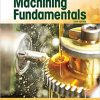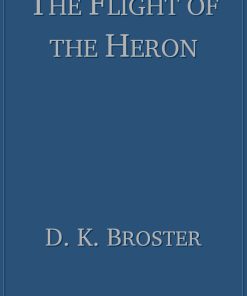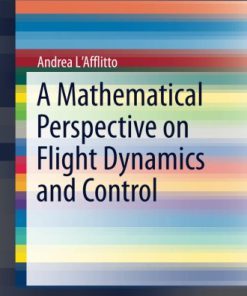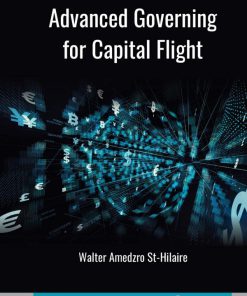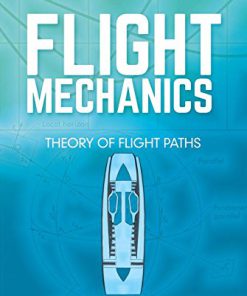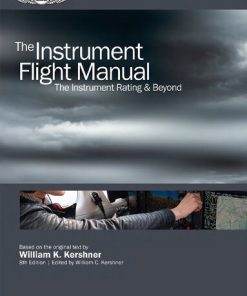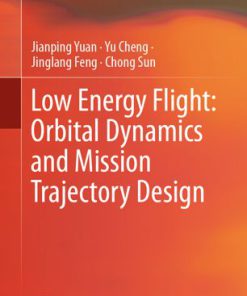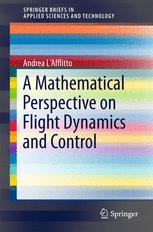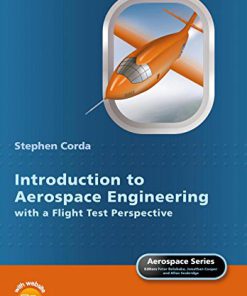Advanced Flight Dynamics with Elements of Flight Control 1st Edition by Nandan Sinha, Ananthkrishnan ISBN 9781351648011 1351648012
$50.00 Original price was: $50.00.$25.00Current price is: $25.00.
Advanced Flight Dynamics with Elements of Flight Control 1st Edition by Nandan Sinha, Ananthkrishnan – Ebook PDF Instant Download/Delivery: 9781351648011 ,1351648012
Full download Advanced Flight Dynamics with Elements of Flight Control 1st Edition after payment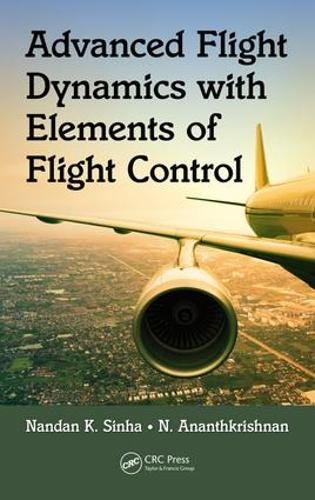
Product details:
ISBN 10: 1351648012
ISBN 13: 9781351648011
Author: Nandan Sinha, Ananthkrishnan
Advanced Flight Dynamics with Elements of Flight Control 1st Edition Table of contents:
Chapter 1: Six Degrees of Freedom Equations of Motion
1.1 Definition of Axis Systems
1.1.1 Body-Fixed Axis System
1.1.2 Earth-Fixed Axis System
1.1.3 Wind-Fixed Axis System
1.2 Definition of Variables
1.3 3–2–1 Transformation
1.3.1 Earth- and Body-Fixed Axes
1.3.2 Earth- and Wind-Fixed Axes
1.3.3 Wind- and Body-Fixed Axes
1.3.4 Relation between the Body-Axis and Wind-Axis Euler Angles
1.4 Relation between Angular Velocity Vector and Euler Angle Rates
1.4.1 Relation between Body-Axis Angular Velocity Components (p, q, r) and Euler Angle Rates (φ, θ, ψ)
1.4.2 Relation between Wind-Axis Angular Velocity Components (pw, qw, rw) and Euler Angle Rates (μ, γ, χ)
1.4.3 Difference between the Body-Axis Angular Velocity (p, q, r) and Wind-Axis Angular Velocity (pw, qw, rw)
1.5 Translational Equations of Motion
1.6 Representation of Forces Acting on the Airplane
1.6.1 Gravity
1.6.2 Aerodynamic Force
1.6.3 Propulsive Force
1.7 Rotational Equations of Motion
1.8 Representation of Moments Acting on the Airplane
1.8.1 Aerodynamic Moment
1.8.2 Propulsive Moment
1.9 Selection of Equations for Specific Problems
1.9.1 Simulation of Arbitrary Maneuver
1.9.2 Steady States Such as Level Flight, Shallow Climb/Descent, Horizontal Turn, Spin, Etc.
1.9.3 Longitudinal Flight Steady States
1.9.4 Constant-Velocity Flight in the Longitudinal Plane
1.9.5 Constant-Velocity Rolling Maneuvers
1.10 Equations of Motion in the Presence of Wind
Reference
Chapter 2: Modeling and Interpreting the Aerodynamics
2.1 Definition of Aerodynamic Coefficients
2.2 Modeling of Aerodynamic Coefficients
2.3 Static Aerodynamic Coefficient Terms
2.3.1 Longitudinal Coefficients with Angle of Attack
2.3.2 Lateral Coefficients with Angle of Attack and Sideslip Angle
2.3.3 Variation with Mach Number
2.3.4 Variation with Control Surface Deflection
2.4 Dynamic Aerodynamic Coefficient Terms
2.4.1 Pitching Moment Due to Relative Pitch Rate, Cmq1
2.4.2 Yawing and Rolling Moment Due to Relative Yaw Rate, Cnr1 and Clr1
2.5 Flow Curvature Coefficient Terms
2.5.1 Yawing and Rolling Moment Due to Wind-Axis Yaw Rate, Cnr2 and Clr2
2.5.2 Pitching Moment Due to Wind-Axis Pitch Rate, Cmq2
2.5.3 Rolling Moment Due to Wind-Axis Roll Rate, Clp2
2.6 Downwash Lag Terms
2.7 Sample Simulation Cases
2.7.1 Example Airplane and Aerodynamic Models
2.7.1.1 F-18 Low-Angle-of-Attack Model
2.7.1.2 F-18/HARV High-Angle-of-Attack Model
2.7.1.3 Pseudo-Steady-State Model for Rapid Rolling Maneuvers
2.7.2 Example Simulation Results
References
Chapter 3: Introduction to Dynamical Systems Theory
3.1 Types of Steady States
3.1.1 Equilibrium States
3.1.2 Periodic States
3.1.3 Quasi-Periodic States
3.1.4 Chaotic States
3.2 Stability of Steady States
3.2.1 Stability of Equilibrium States
3.2.2 Stability of Periodic Orbits
3.3 Bifurcations of Steady States
3.3.1 Stationary Bifurcations of Equilibrium States
3.3.1.1 Saddle-Node Bifurcation
3.3.1.2 Transcritical Bifurcation
3.3.1.3 Pitchfork Bifurcation
3.3.1.4 Perturbation to Transcritical and Pitchfork Bifurcations
3.3.2 Hopf Bifurcation of Equilibrium States
3.3.3 Bifurcations of Periodic States
3.4 Continuation Algorithms
3.5 Continuation Framework for Multiparameter Systems
3.5.1 Scheduling the Parameters in a Multiparameter System
3.5.2 Influence of Aircraft Control Parameters on Constraints
References
Chapter 4: Longitudinal Flight Dynamics
4.1 Longitudinal Steady States (Trims)
4.1.1 Modeling Engine Thrust
4.2 Longitudinal Trim and Stability Analysis
4.2.1 Longitudinal Trim and Stability with Varying Angle of Attack
4.2.2 Longitudinal Trim and Stability with Varying Throttle Setting
4.3 Level Flight Trim and Stability Analysis
4.3.1 Level Flight Airplane Performance
4.4 Climbing/Descending Flight Trim and Stability Analysis
4.5 Pull-Up and Push-Down Maneuvers
4.6 Wind Effects on Longitudinal Dynamic Modes
Reference
Chapter 5: Longitudinal Feedback Control
5.1 Generic Flight Control System
5.2 Airframe, Sensor, Filter, Actuator
5.3 Generic Longitudinal FCS Structure
5.4 Longitudinal Flight Control Modes
5.5 Longitudinal Feedback Control Law
5.5.1 Gain Scheduling
5.6 Dynamic Inversion Control Law
5.7 Closed-Loop Stability Analysis
5.7.1 With Thrust Vectoring Control Included
References
Chapter 6: Lateral-Directional Flight Dynamics and Control
6.1 Lateral-Directional Modes in Straight and Level Longitudinal Flight
6.2 Horizontal Level Turn Trims
6.2.1 Formulation and Constraints
6.2.2 Parameter Schedules
6.2.3 Turn Performance
6.3 Nonzero Sideslip Trim and Stability Analysis
6.4 Wing Rock Onset and Its Prediction
6.4.1 Analytical Criterion for Wing Rock Onset
6.4.1.1 Second-Order Form of the Perturbed Lateral-Directional Equations
6.4.1.2 Matrix Form of the Perturbed Lateral-Directional Equations
6.4.1.3 Static Instability Criterion
6.4.1.4 Approximation by Hamiltonian Dynamical System
6.4.1.5 Dynamic Instability Mechanism
6.5 Lateral-Directional Feedback Control System
References
Chapter 7: Coupled Lateral–Longitudinal Flight Dynamics
7.1 Inertia Coupled Roll Maneuvers
7.1.1 Zero-Sideslip Roll Maneuvers
7.1.2 Velocity-Vector Roll Maneuvers
7.2 High AOA Flight Dynamics and spin
7.2.1 Analytical Criterion for Spin Susceptibility
7.2.1.1 Derivation of the Criterion
7.3 Bifurcation Tailoring/Trim Shaping as Control Strategy
7.3.1 Linear ARI Law for Jump Prevention
7.3.2 Trim Shaping for Level Flight Trims
7.3.3 Rolling Pull-Down Maneuver with Zero Sideslip
7.4 Control Prototyping for Recovery from Spin
7.4.1 Spin Recovery Using Sliding Mode Control
7.5 Carefree Maneuvering Using Sliding Mode Controller
7.5.1 Minimum Radius Turn Maneuver Using Sliding Mode Controller
7.5.2 Maneuver Design Based on AER
References
Chapter 8: Dynamics and Control of a 10-Thruster Flight Vehicle
8.1 Flight Dynamics of the 10-Thruster DACS
8.2 Modeling the Thruster Forces and Moments
8.3 Modeling the Change in CG and Moments of Inertia
8.4 Modeling the Aerodynamic Forces and Moments
8.5 Control and Guidance Framework for 10-Thruster DACS
8.6 DACS Control Law
8.6.1 Navigation Equations and Flight Path Controller
8.6.2 Attitude Equations and Attitude Controller
8.6.3 Rate Equations and Rate Controller
8.6.4 Issue of Invertibility
8.6.5 The Question of Stability
8.7 DACS Guidance Law
8.7.1 Derivation of Dynamic Inversion-Based Guidance Law
8.7.1.1 In Terms of Azimuth and Elevation Angles
8.7.1.2 A Question of Invertibility
8.7.1.3 Decoding the Inversion-Based Guidance Law
8.8 Simulation of 10-Thruster DACS Flight with Guidance and Control
Reference
Index
People also search for Advanced Flight Dynamics with Elements of Flight Control 1st Edition:
advanced flight dynamics with elements of flight control
dynamics terms and symbols
what are the elements of dynamics
what is dynamic stability of an aircraft
Tags:
Nandan Sinha,Ananthkrishnan,Advanced Flight,Dynamics,Elements
You may also like…
Fiction - Literary Fiction
Politics & Philosophy
Technique - Transport
Uncategorized
Engineering - Aerospace Engineering
Mathematics - Automatic Control Theory
A Mathematical Perspective on Flight Dynamics and Control 1st Edition Andrea L’Afflitto (Auth.)
Engineering
Introduction to Aerospace Engineering with a Flight Test Perspective 1st Edition Stephen Corda


